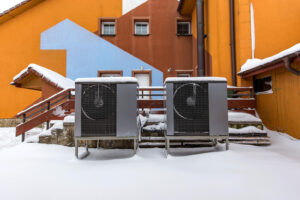
Guest post: How the Greenland ice sheet fared in 2023
Multiple Authors
10.17.23Multiple Authors
17.10.2023 | 3:23pmThe Greenland ice sheet melt season 2023 is now over and it completes a 27th year in a row in which Greenland has lost ice.
The 2022-23 year saw both very high melt, particularly in July, but also higher than usual rain and snowfall in the late spring and early summer.
The increase in both melt and snowfall are exactly what scientists expect in a warming climate, and although they have tended to balance each other to some extent, Greenland has still ended up losing more ice than it gained.
As in previous years, while very high temperatures hit North America and Europe this summer, Greenland in between was comparably cool and wet. However, this was not enough to stop Greenland losing ice.
Extended snowfalls from October to December 2022 and the late onset of the melt season contributed to a relatively large accumulation of mass on Greenland’s surface. Nonetheless, this could not outweigh the losses by surface melting and breaking off of icebergs.
Overall, Greenland’s ice sheet lost 196 billion tonnes (Gt) of ice over the 12 months from September 2022 to August 2023.
This means that the last year to see a net gain of ice is still 1996.
In this annual guest post, we discuss the processes of ice sheet melt, glacier “calving” and the weather and climate that explain these losses.
(See our previous annual analysis for2022,2021,2020,2019,2018,2017,2016and2015.)
Surface melt
Greenland’s annual cycle covers the 12 months up until the end of August.
The pattern sees the ice sheet largely gain snow from September, accumulating ice through autumn, winter and into spring. Then, as the year warms up into late spring, the ice sheet begins to lose more ice through surface melt than it gains from fresh snowfall, generally from the end of June. This melt season usually continues until the middle or end of August.
The snow gains and ice losses at the ice sheet’s surface over these 12 months are the “surface mass balance” (SMB) of the ice sheet. The SMB consists of gains through snowfall and losses through runoff and evaporation. Therefore, snowfall is the only way for the ice sheet to gain mass.
The data suggest that the Greenland ice sheet ended the year 2022-23 with a total SMB of about 398Gt. This is the 15th highest SMB in a dataset that goes back 43 years and is quite close to the 1981-2010 average.
The past year’s SMB is illustrated in the maps and charts below, based on data from thePolar Portal. The blue line in the upper chart shows the day-to-day SMB. Large snowfall events become visible as “spikes”. The blue line in the lower chart depicts the accumulated SMB, counted from the beginning of the “mass balance year” on 1 September 2022. In grey, the long-term average and its variability are shown. The red line shows the record low year of 2011-12 for comparison.
The map shows the geographic spread of SMB gains (blue) and losses (red) for 2022-23, compared to the long-term average.

Heat over North America and Europe, cool over Greenland
A closer look at the weather and ice sheet changes through the past 12 months reveals some interesting developments.
Early winter began with above-average snowfall on several occasions in September, October, November and December. In late winter, a rather dry period followed, so that the accumulated SMB was close to – and then slightly below – average as melting began.
The most remarkable feature in the evolution of the SMB in 2023 was the extended period of growth in June. At the end of that month, the accumulated SMB was almost 150Gt above average.
The effect of this extra snow meant that the onset of the melt – or “ablation” season was on 29 June – 16 days later than the 1981-2022 median. The ablation season is defined as the first day of three days in a row with an SMB below -1Gt.
As in previous summer seasons, the reason for the comparatively wet and cool spells over the Greenland ice sheet can be found quite far away from Greenland in “blocking” weather patterns.
These high-pressure weather systems have a huge impact on weather extremes. Strong persistent blocks over North America and Europe were present in the end of May and the first decade of June and at the end of August. The last of thesecaused catastrophic rainfallin Greece and Libya.
In such a blocked flow, thejet streamis shaped like the Greek capital letter Omega (Ω). Research suggests that such patterns in recent yearshave been stronger and more persistent. With the jet stream bulging up to the north over Canada and northern Europe, troughs of low pressure are found at each “foot” of the omega – including over Greenland.
The map below shows an example of the recurring circulation patterns, bringing cool weather over Greenland (blue shading) along with high temperatures over Canada and Europe (red shading).

The melt season that followed was stronger than average – even comparable with the record years of 2012 and 2019 – with melting over more than 50% of the ice sheet for 29 days in a row, from 27 June to 25 July.
And while the world was rightly focused on otherextremeweathereventsthis summer, the Greenland summer also saw its own record-breaking conditions.
The station at the summit of Greenland – about 3,000 metres above sea level – recorded a new average temperature record of -7.3C, almost 2C warmer than the previous record of -9.2C set in 2012 and 4C warmer than the long-term average at summit station.
Melt season
There were two main melting periods of the ablation season. Despite the cool start, as the melt season got underway there was a period of very high temperatures at the end of July. This brought intense melt all around the ice sheet that led to very large ice losses over a few days.
The map on the left side shows the area of ice melt on 10 July when the maximum melt extent (67%) of this summer (shaded in red) was reached. The centre map shows the second melt maximum (50%), which peaked on 23 August, and finally the map on the right depicts the situation at the end of the season on 31 August. Melting was above average from 21 June through to – and beyond – the end of the season.

Components of the mass balance
The SMB is just one component of the “total” mass mass balance (TMB) of the Greenland ice sheet:
TMB = SMB + MMB + BMB
Here, MMB is the “marine” mass balance, consisting of the breaking off – or “calving” – of icebergs and the melting of the front of glaciers where they meet the warm sea water. BMB is the “basal” mass balance, which refers to ice losses from the base of the ice sheet. This makes a small, but non-zero, contribution to the TMB and mainly consists of frictional effects and the ground heat flux.
The figure below shows the components of the TMB (red) going back to 1987, which includes the SMB (blue), MMB (green) and BMB (orange). These estimates are based on the modelling approach set out inMankoff et alin 2021.
For the past year, the TMB clocked in at a loss of 196Gt of ice. This means that 2022-23 was the 27th year in a row where the Greenland ice sheet has lost mass overall. As the chart shows, Greenland last saw an annual net gain of ice in 1996.

The only way for the ice sheet to gain ice is via the SMB – that is, through snowfall. The other components, MMB and BMB, are always negative, so the surplus of snowfall over runoff and the two other components needs to be large enough to compensate.
Using data from theGRACE satellites, we can estimate the TMB independently. The distance of these twin satellites changes slightly due to tiny gravity differences caused by mass changes. Expressing these distance differences as mass changes is not straightforward, however, which is the reason why GRACE data are only made available a few months later.
Furthermore, using satellites, we can measure the speed at which ice flows through control points on the ice sheet where we know the thickness and shape of the ice. Thus, we can estimate MMB, the amount of ice being lost by the process of calving and submarine melting. This data isopenly available, allowing usto monitorthe whole ice sheet budget.
The map and graph below show the gain (blue) and loss (red) in the mass of ice. The difference in these mass changes over a glaciological year (September-August) is the TMB of the ice sheet for that particular year.

地图显示,大部分的冰发生的损失along the edge of the ice sheet, where independent observations also indicate that the ice is thinning. High up in central Greenland, there is a small increase in the mass of the ice – most likely due to a small increase in snowfall, as we would also expect in a warming climate.
The graph illustrates the month-by-month development in changes of mass measured in gigatonnes, relative to April 2002. The left axis on the graph shows how this ice mass loss translates into a sea level rise contribution, where 100Gt corresponds to 0.28mm of global sea level rise.
The two approaches to calculating TMB have a common period of 1 April 2002 to 31 March 2023. These estimates suggest that the Greenland ice sheet lost around 4,578Gt (Mankoff et al.) to 4,745Gt (GRACE) of ice over this time. Note that the two methods are completely independent.
The result from both datasets is equivalent to around 13mm of global average sea level rise.Recent researchsuggests that the imbalance of the Greenland ice sheet caused by climate change means it is committed to contributing at least 274mm to global sea levels in future, regardless of 21st-century climate pathways.





